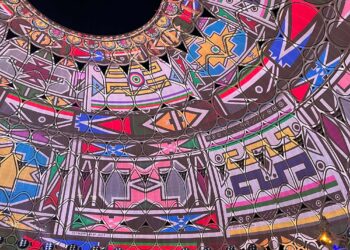Let’s start with a discussion about economics. That’s not very sexy, is it? And creativity usually is sexy in some way, or if that’s the wrong word then how about: expressive, visceral, thoughtful, embodied, emotive, meditative, sensitive, impassioned, provocative… Relevant? Valuable? That’s harder to assess.
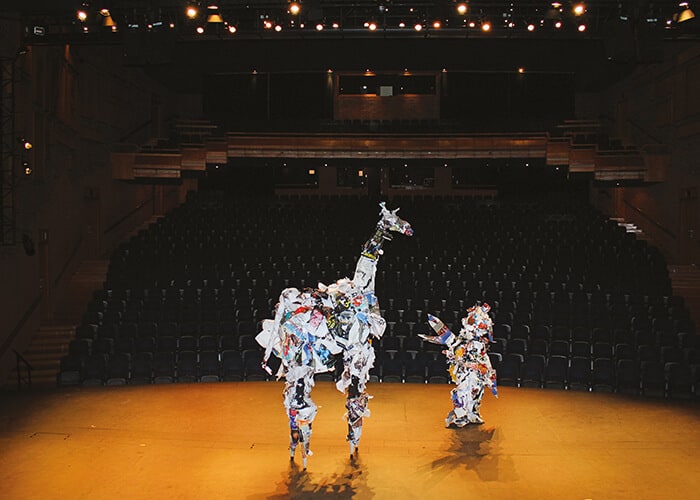 Siyabonga Bawuti, Ayanda Nondlwana, Athenkosi Nyikilana, Monwabisi Dondashe and Francois Knoetze, detail of collaborative performance of Semi-Gloss at the Grahamstown National Arts Festival, 2016. Photo: Francois Knoetze. Image courtesy of the artists.
Siyabonga Bawuti, Ayanda Nondlwana, Athenkosi Nyikilana, Monwabisi Dondashe and Francois Knoetze, detail of collaborative performance of Semi-Gloss at the Grahamstown National Arts Festival, 2016. Photo: Francois Knoetze. Image courtesy of the artists.
Let’s go back to economics. I start National Arts Festival 2016 at Jen Snowball’s Think!Fest talk Mapping the Cultural Industries in South Africa. Introducing the South African Cultural Observatory (the Department of Arts & Culture’s new national public research entity), Snowball succinctly describes methods of statistical economic research, as well as the pitfalls of analysing creative industries in this way. I’m struck by a Powerpoint graphic which depicts economic value in terms of three aspects: employment opportunities, transformation/ social cohesion and financial turnover. How interesting it would be to analyse the value of creativity if we could come up with questions that interrogated the socio-cultural value of the work away from financial concerns. This, Snowball points out, is always the hardest part in analysing creative output. Quantitative research is easier to measure than qualitative. No one wants a creative sphere driven exclusively by the bureaucracy of policy makers, but that does not mean there aren’t some important questions which need to be asked about what and how we place value on creative production. National Arts Festival should be a good place to ask such questions.
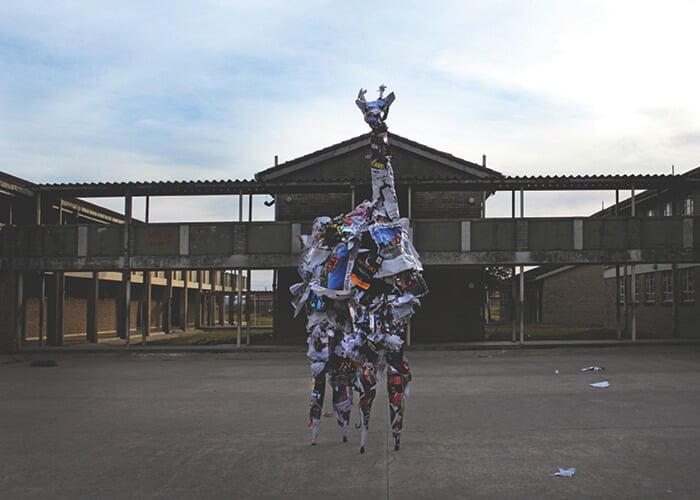 Siyabonga Bawuti, Ayanda Nondlwana, Athenkosi Nyikilana, Monwabisi Dondashe and Francois Knoetze, detail of collaborative performance of Semi-Gloss at the Grahamstown National Arts Festival, 2016. Photo: Francois Knoetze. Image courtesy of the artists.
Siyabonga Bawuti, Ayanda Nondlwana, Athenkosi Nyikilana, Monwabisi Dondashe and Francois Knoetze, detail of collaborative performance of Semi-Gloss at the Grahamstown National Arts Festival, 2016. Photo: Francois Knoetze. Image courtesy of the artists.
In his curatorial statement, Ismail Mahomed (now in his final year as festival artistic director), comments on how significant South African anniversaries were key in developing a curatorial vision for the 2016 programme. The tenth anniversary of the Civil Unions Act, twenty years since the TRC, the fortieth year since the Soweto Uprising, sixtieth anniversary of the Women’s March to Pretoria, sixty-five years since the signing of the Freedom Charter, Fort Hare’s centenary, and two-hundred years since Shaka ascended the throne of the Zulu monarchy would seem to make 2016 an auspicious year. Reflecting on this past in order “to critique the present and to re-envision the future” is Mahomed’s reasoning for this anniversary focus. Potentially, but overemphasis on this past must be heavy for young voices wanting to tell the stories of their ‘now’ experiences under the weight of so much history. Anniversaries of unexperienced first hand events can be like monuments looming on one’s horizon. Every generation must cope with, redress, or reinvent its history, but it should be an ingredient in the dish, not the whole meal. It cannot be an easy task to preconceive a curatorial theme for a festival which has an array of stories, genres and audiences in mind. In retrospect then, what were the stories and what were the questions?
Labour was a focus at this year’s Festival. But how much is it a theme, and for who is it an actuality? Before Fest a friend of mine, Febz, was discussing with me options for ways to make extra capital during this peak period. Like many locals from Grahamstown, he sees the influx of people as an opportunity to earn some extra capital. Last year he helped a comedian put up posters. Rather than money, Febz was promised free tickets. When the job was done, he was told: “No, not tickets for this year. Next time!” Together we are looking for events advertised as free. How to navigate this is a labour in itself. Paging through the Festival guide, we come across last year’s comedian whose blurb describes his ‘often misunderstood’ and ‘unusual’ sense of humour. “It’s probably promising people free tickets and then reneging,” I say. “Yes,” he says, “I’m still to get that one.”
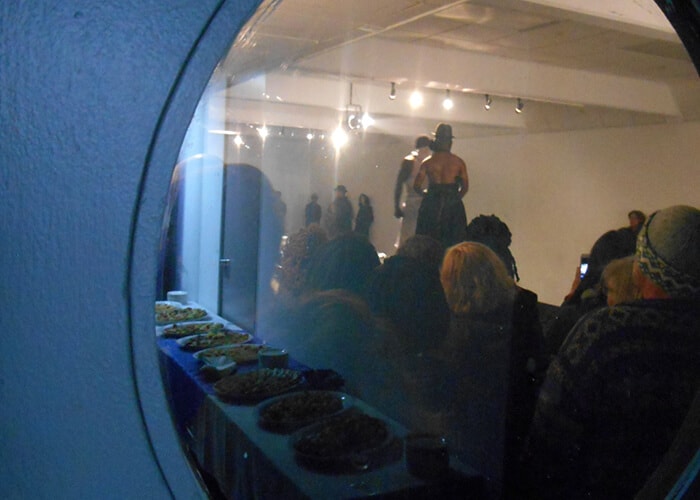 View of Mohau Modisakeng’s performance Lefe La Ntate through Monument Gallery porthole with reflected VIP snacks. Photo: Rat Western. Image courtesy of Rat Western.
View of Mohau Modisakeng’s performance Lefe La Ntate through Monument Gallery porthole with reflected VIP snacks. Photo: Rat Western. Image courtesy of Rat Western.
The next day he tells me he has a potential part in a performance. His high school arts and culture teacher died the previous week. There is a moment of stillness, all too familiar, when someone dies just as you’re about to finally do that thing that might make them proud. This story, of those who are treated as only temporarily useful for their creativity and labour and then disregarded till next year, is mirrored in the public performance and film Semi-Gloss. This project was developed by Ayanda Nondlwana, Siyabonga Bawuti, Monwabisi Dondashe, Athenkosi Nyikilana and Francois Knoetze. Using the detritus of last year’s Festival posters to fashion their costumes, this materiality doubles as a metaphor for the waste and abandonment of local artists after yet another year’s Festival. Four free public performances and daily free film screening demonstrates that these artists prize accessibility over exclusivity. On the other end of the elitist scale, is the opening performance of the Standard Bank Young Artist for Visual Art: Mohau Modisakeng. By invitation only, this event takes place on the Friday evening. I don’t receive an invitation. I go anyway. Someone has told me the event started later than it did. No matter, it’s still going on. After providing a small amount of consternation for the support staff who seem to think I should have been invited and are concerned that somehow amongst all their other labours this short fall will be their problem, I reassure them: I’m not an important whatwhat. And if I were? Why is this intended celebration of what is presumed to be a high achiever in South African visual culture only for important invited what-whats? I watch at a distance through the port-hole on the door which perhaps gives a clearer view than if I’d been jammed like a sardine in the stuffy room. I recognise, with surprise, one of the chief performers. Febz. He has amazing stage presence. Later, I think, I will get an insider perspective to balance my present outsider one.
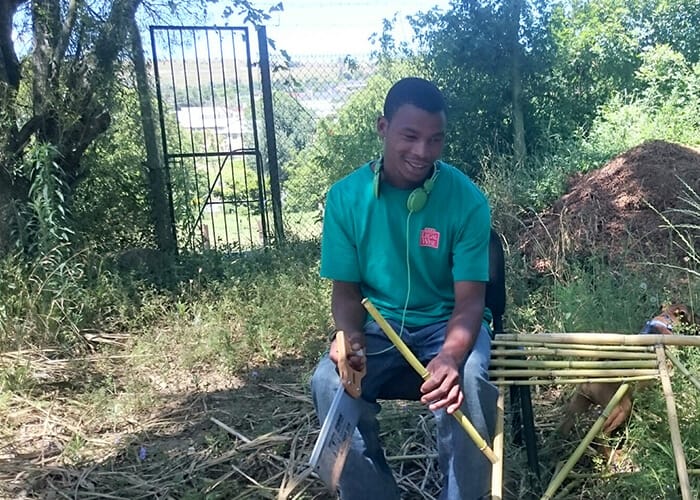 Phatuxolo ‘Febz’ Wayi designing a bamboo gate. Photo: Rat Western.
Phatuxolo ‘Febz’ Wayi designing a bamboo gate. Photo: Rat Western.
National Arts Festival has an array of artist walkabouts, neatly marked with an asterisk if either the artist or curator will be present – R40 a ticket if you’d like the work explained to you. Instead of the artist, many such talks will be led by some ill-briefed understudy who will repeat the required script and field unfortunate questions with the defence that they are not the artist so cannot speak for them. The position is not an enviable one, merely an opportunity for some aspiring creative who has taken on what they thought was an opportunity in providing a favour to those better connected. If the individual is Grahamstown based, such opportunities are not common. This is not the case for Lerato Shadi’s Noka Ya Bokamosa walkabout.
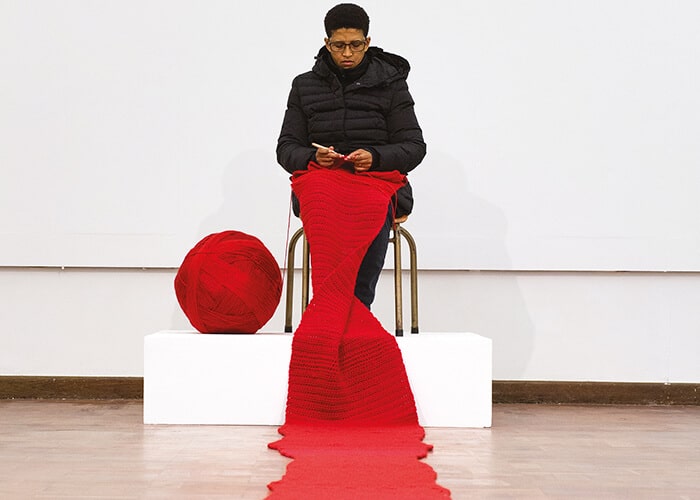 Lerato Shadi, detail of Mosako Wa Nako, 2016. Performancce, at the Grahamstown National Arts Festival, 2016. Photo: Erik Dettwiler. Image courtesy of the artist and Joan Legalamitlwa.
Lerato Shadi, detail of Mosako Wa Nako, 2016. Performancce, at the Grahamstown National Arts Festival, 2016. Photo: Erik Dettwiler. Image courtesy of the artist and Joan Legalamitlwa.
Curator, Joan Legalamitlwa, briefs the audience on the guiding concepts of the works: a video performance in which the artist binds her tongue, a figure dressed in red explores a landscape, the artist and her mother lick sugar and salt interchangeable from each other’s tongues. Legalamitlwa does not tell us what the work is but rather tells us her impressions of it. She speaks of how the work makes her feel, not what the artist means by it. She describes the mother and red figure (choreographer Sello Pesa) as collaborators rather than disregarding them as mere actors in the artist’s vision. The reason for the curator being the voice at this point is evident. The artist is present, but she performs an ongoing labour of knitting a shoulder-width red strip. 10am-4pm each day of the festival she twines and knots herself into this ever growing red-road. Without break, she labours quietly in the path of a thousand unrecorded ancestors. This is not an act of monumentalising a glorious individual, but rather a commemoration of those who, unwritten, quietly laboured with the job of getting on with the journey. The artist makes no great place for herself either. She continues the act of monotony, discomfort and production that has been the lot of many. For her in particular, the lot of black women. She makes clear, however, that she does not aim to represent all black women. This is the angle she takes whilst reflecting on the unrecorded in her family – an attempt to recoup an unacknowledged or obliterated history through a mirrored act of labour and sacrifice.
She takes one afternoon off to address questions from an audience who have been invited to put their names down when visiting the show. The places are limited as the space is limited, but there is no cost to hear the artist speak. “Is it hard?”, someone asks her: “It is harder than the job of a CEO, but easier than working in a chicken factory.”
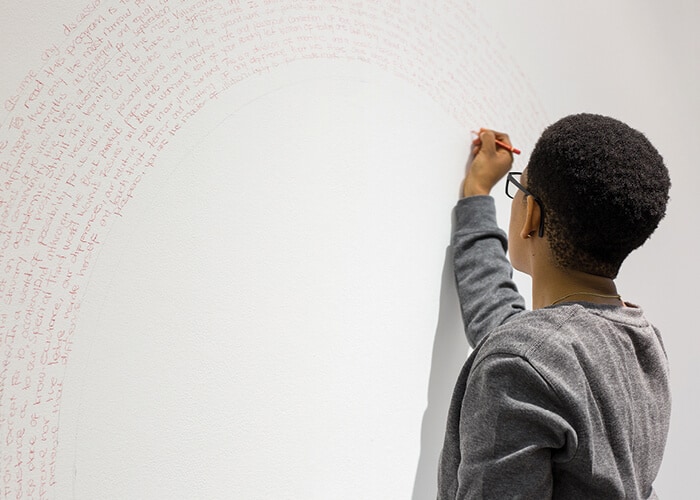 Lerato Shadi, Makhubu, 2016. Performance and installation. Photo: Erik Dettwiler. Image courtesy of Joan Legalamitlwa.
Lerato Shadi, Makhubu, 2016. Performance and installation. Photo: Erik Dettwiler. Image courtesy of Joan Legalamitlwa.
For those keen to hear more artists, theatre makers and academics discussing the burning issues of the current cultural moment there is the Think!Fest lecture series.
The theatre talks are more lively than the visual art, more articulate. Perhaps because these are people who make their living through words and actions. Someone mentions the importance of not making presumptions about identities or presenting stereotypes, someone else says it’s difficult for a two dimensional being to speak and it is only a three dimensional character that can have a voice. They talk about their audiences, about making things more accessible – both physically and affordably. In a discussion of theatre’s role in reconciliation, the debate is whether works should have trigger warnings to avoid re-traumatising audiences or whether art should point to where it hurts in our society. Do we hold with an Aristotelian vision that art can bring us to the edge and then resolve? I take my ten year old son to Gavin Krastin’s Pig Headed. Krastin pegs his mouth an increment at a time whilst he reads the South African constitution. Thus hobbled, he still manages to articulate the visions of a dazed and confused rainbow. A mouse trap stifles his tongue whilst he reads the bit on education. A bit later he cuts his feet with a scalpel. The audience squirms. So does my son. I lean over to check if it might be a bit much for him. He says: “Now he’s just trying too hard.” Audiences are less sensitive than we think. But perhaps not sensitive enough.
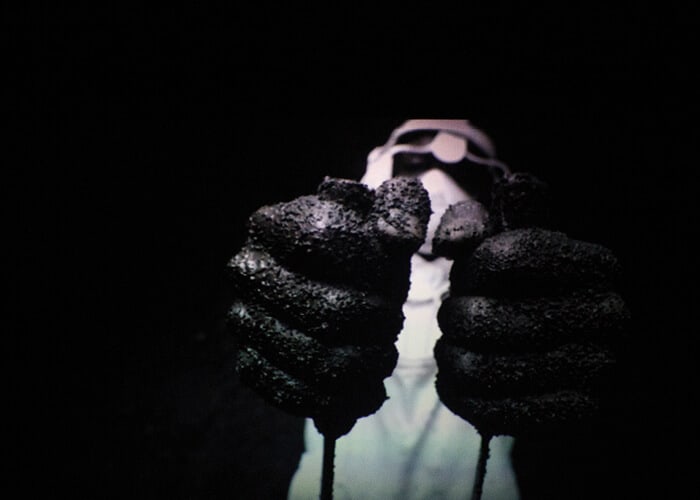 Mohau Modisakeng, still from Lefa La Ntate, as shown at the Grahamstown National Arts Festival, 2016. Image courtesy of Cue/Dani O’Neill and WHATIFTHEWORLD.
Mohau Modisakeng, still from Lefa La Ntate, as shown at the Grahamstown National Arts Festival, 2016. Image courtesy of Cue/Dani O’Neill and WHATIFTHEWORLD.
A young black female student asks at one of the Think!Fest events: “Shouldn’t all artworks attempt to be reconciliatory? Black pain has too long become a useful aesthetic – a cash-cow. Who is responsible for calling it out?” We should ALL be brave enough to ask such questions. So I’ll call it.
Modisakeng presents a body of work under a Setswana name, but the bodies performing it speak isiXhosa. The titling means nothing to them, half of them have not even been told what the title is, never mind the concept – but the subtleties would escape the average whitey, so that’s okay? They have been told the work is about labour and mining. One thing they know about and another is at a remove from their individual experience. Clearly it is for Modisakeng too, who name-drops Marikana at his walk-about when asked about his use of coal in the work. Marikana is a platinum mine, possibly more useful for a work about economics and labour? Aesthetically, it would be less easy. The labour is to go the same way as the detritus posters of Semi-Gloss except these won’t even make the eleven days of Festival. Once off for a selected audience is all they get. When I ask at the walkabout why the performance is not reiterated for those who are having the tale retold but would clearly like to see it, Modisakeng says, “Because it’s impossible to get sixteen people again… well not impossible but…well hard.” There were several fringe shows at Festival that managed this for consecutive nights. It’s hard to believe that someone with a curator and all that funding couldn’t even present a recorded artefact of the happening. Another walkabout visitor asks about the artist’s personal politics which the press release determine are part of the work. He talks about growing up in Soweto, in a township, about a mother and father who went to work in the early morning and came home late at night. Middleclass then? This is not the story of the black workingclass labourer. There is a disjuncture here.
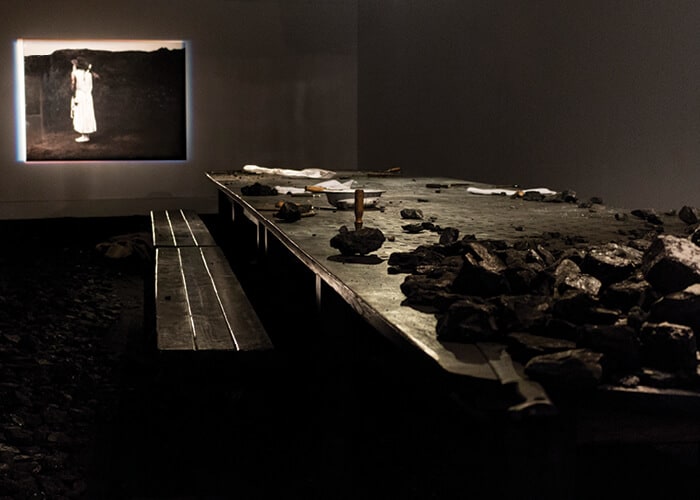 Mohau Modisakeng, installation view of Lefa La Ntate, Grahamstown National Arts Festival, 2016. Image courtesy of Cue/Dani O’Neill and WHATIFTHEWORLD.
Mohau Modisakeng, installation view of Lefa La Ntate, Grahamstown National Arts Festival, 2016. Image courtesy of Cue/Dani O’Neill and WHATIFTHEWORLD.
Modisakeng, however, is also a cog in an all too common story of a young artist being picked up far too soon before he has found his own voice – flattened into two dimensions which are easier to market to international audiences. He has a good eye and would have made a great fashion photographer. The inconsistencies in his conceptualisation and politics makes me wonder whose story he is telling. I’d rather hear his own.
“The show will go to Cape Town,” says Febz, contemplating whether he might be recast. Then with a second thought says: “I’ll never go to Cape Town.” He smiles, pocketing the cash he earned from building a fence at a local school – his labour during the rest of the Festival period. I don’t know that I feel bad for him.
Rat Western is a senior lecturer in the Department of Fine Art, Rhodes University.
This article was first published in the September 2016 edition of ART AFRICA magazine, entitled ‘BEYOND FAIR.’


